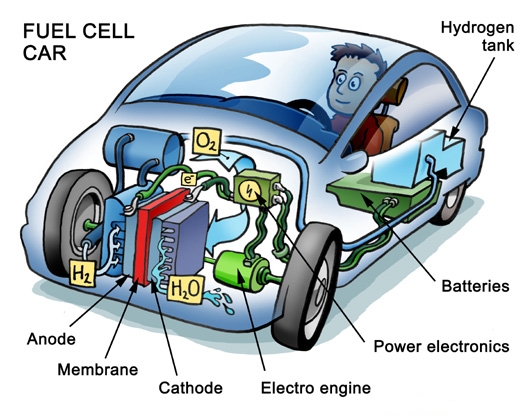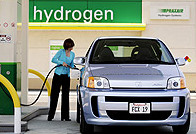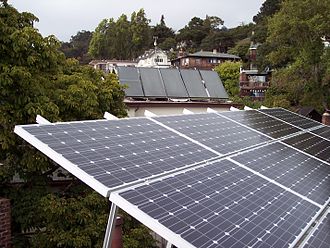
Configuration of components in a fuel cell car. (Public Domain)
Ringside: The Many Colors of Hydrogen
As much as 5 trillion tons of naturally occurring hydrogen exist in underground reservoirs worldwide
By Edward Ring, January 9, 2025 12:03 pm
 The lightest and most abundant substance in the universe, the simplest possible molecule, hydrogen (H2), is touted as the clean burning fuel of the future. Zero pollution. But how can hydrogen be extracted or manufactured in its pure form, and how can hydrogen be stored, distributed, and converted into practical applications?
The lightest and most abundant substance in the universe, the simplest possible molecule, hydrogen (H2), is touted as the clean burning fuel of the future. Zero pollution. But how can hydrogen be extracted or manufactured in its pure form, and how can hydrogen be stored, distributed, and converted into practical applications?
If you’re following the evolution of energy technology and energy policy, you’ve probably heard hydrogen categorized using colors. They denote the various ways hydrogen is sourced. It’s become quite a list, but there are three basic (somewhat overlapping) categories: (1) extracted from water, (2) extracted or generated in other ways including from fossil fuel, or (3) naturally occurring and extracted from deposits in the earth.
The most environmentally correct version of the first category is referred to as green hydrogen. It relies on electrolysis, a process where an electric current is passed through water, causing it to separate into hydrogen and oxygen atoms. But to be “green” hydrogen, that electricity has to come from renewable sources such as solar or wind.
Pink hydrogen (sometimes also referred to as purple or red hydrogen) relies on nuclear power for the electricity. Yellow hydrogen, a subset of green hydrogen, is hydrogen that is created using solar generated electricity.
We’re just getting started. The second category begins with grey hydrogen. It is the most common production method currently used, where the H2 molecules are extracted from methane. This process releases CO2 along with hydrogen, but if that CO2 is sequestered or processed instead of released to the atmosphere, you have what is referred to as blue hydrogen. And then there is brown hydrogen, extracted from lignite (brown coal), and black hydrogen, extracted from black coal.
The hydrogen spectrum in this category also includes turquoise hydrogen. It relies on a process where methane is split into hydrogen and solid (instead of gaseous) carbon. Since solid carbon has many industrial uses, this technology is getting a lot of attention.
Our journey into H2 chromaticism now moves to the so-called “stimulated” hydrogen, starting with gold hydrogen, produced by, for example, microbes fermenting in depleted oil wells. Other stimulated forms of hydrogen include orange hydrogen, which is geochemically induced underground by, for example, injecting CO2 charged water into iron rich rock formations. Who knew?
And then there is “clear” hydrogen, another high potential, vaguely defined subcategory. From Real Clear Energy, “Clear hydrogen is produced by extracting hydrogen from water, like green hydrogen, but rather than using electrolysis to ‘zap’ the hydrogen away from the oxygen, a new technology does so using water that is subjected to external influences coupled with extremely rapid variations in pressure, temperature and motion.” Got that?
Which brings us to our final category, with just one color: white hydrogen, also known as natural or geological hydrogen. Generating increasing attention and some excitement, this is hydrogen that has already been produced by nature via natural geologic processes in the earth. A report in the Financial Times quotes experts suggesting as much as 5 trillion tons of naturally occurring hydrogen exist in underground reservoirs worldwide. To put that in perspective, hydrogen packs 125 million BTUs of energy per ton, which means there may be 625 quintillion BTUs of hydrogen sitting in the ground, waiting to be extracted. Total global energy consumption per year currently sits at around 600 quadrillion BTUs. Theoretically, white hydrogen could power the world for more than 1,000 years.
Theoretically is the key word here. Billions of dollars are being poured into research into hydrogen production, and for every shade of H2, there are challenges. What about storing hydrogen, distributing hydrogen, and converting hydrogen back into usable power? Here, too, there are many challenges.
To begin with, practical quantities of hydrogen have to be stored either under high pressure, or in a state so cold that it liquifies. Both methods require expensive systems and a lot of energy. For example, to offer sufficient range on a vehicle that uses a fuel cell to convert the hydrogen back into electricity, the on-board tank has to withstand between 5,000 and 10,000 PSI, requiring specialized materials. Hydrogen doesn’t turn to liquid until the tank is cooled to over 400 degrees below zero Fahrenheit. As the lightest gas in the universe, hydrogen has to be stored at the highest pressure. This means thicker and heavier tanks, and more energy needed to compress the hydrogen into the tank.
Distribution of hydrogen is also a challenge. Some of the most common pipe materials, including steel, aluminum, and titanium, become brittle if they are used to transport hydrogen gas. For this reason, one solution has been to retain use of natural gas with at most 15 percent added hydrogen. That’s fine if our goal is reasonable carbon intensity targets. For the net zero crowd, however, we would have to replace pretty much every gas pipeline in the world.

And then there are the uses of hydrogen. Skeptics shouldn’t laugh too loud. Yes, fuel cells are resource intensive, still have durability problems in mobile applications, and only turn about 60 percent (if that) of the onboard hydrogen into electricity to power the EV. But there are processes to convert hydrogen into vital components of synfuels, or ammonia, as feedstock for many other industrial processes, and even in the production of steel.
Like nuclear fusion, thorium reactors, advanced photovoltaics, factory farmed biofuel, enhanced geothermal, and additional technologies that we can’t yet imagine, hydrogen is a tantalizing and rapidly developing energy option. Achieving affordable energy abundance requires striking a balance between our attempts to commercialize these emerging alternatives and preserving our robust installed base of conventional energy options.
- Ringside: Will Advocates for More Water Supply Projects Find Unity? - December 11, 2025
- Ringside: EVs and California’s Future Demand for Electricity - December 4, 2025
- Ringside: Politically Viable Water Supply Projects - November 27, 2025





This is the actual future of transportation that progressives willfully ignore
Physics for Future Presidents; Richard A. Muller